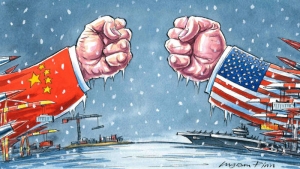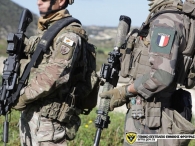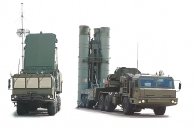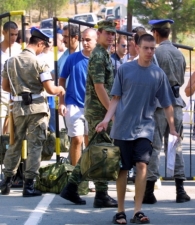China's Military Rise: Geopolitical and
International Security Implications
By Dr Aristos Aristotelous
Ex Member of Parliament, Director of the Cyprus Centre for Strategic Studies
Introduction
“China is a sleeping giant. Let her sleep, for when she wakes, she will move the world” (1). – A phrase attributed to Napoleon Bonaparte in 1803. Is this the case today?
During the last few decades, China has risen to formidable power with an enhanced role in the international scene regionally and globally. On the one hand, developments led to increased Chinese military capabilities and effectiveness as well as to the promotion of the foreign and security policy aspirations of the county’s leadership. On the other hand, it alters the strategic and geopolitical landscape in its immediate neighborhood and beyond, while competing powers view it as a challenge, a threat, or a cause for concern.
This study aims to deal with the issue of China’s rising military power over the last decades and assess its strategic, geopolitical, and security implications. We shall, thus, look at the context in which this development is taking place, the correlation between economic growth and China’s increased military spending, and its significance in comparison to other powers. We shall then look at how the military utilized these resources in its weapons and capabilities’ development program and to promote Chinese national goals. We shall also refer to the strategic, geopolitical, and security implications of China’s growing military might at the regional and broader international levels, which the U.S. perceives as posing a severe challenge to its supremacy and its regional allies. Finally, we draw our conclusions.
The analysis
1. The context – the “China Dream”
Political, ideological, and security considerations, together with economic factors and the so-called China Dream envisioned by the country’s leadership provide the background and the driving forces behind the increase in China’s military strength over the last decades.
Since 1979, when the regime in Beijing adopted free-market reforms and opened its economy to international trade and foreign investment, China has become one of the most rapidly developing countries in the world, and has demonstrated an impressive annual growth in gross domestic product (GDP) which has led to the World Bank describing it as “the fastest sustained expansion by a major economy in history” (2). Over the last decades, China has become the world’s largest economy, manufacturer, merchandise trader, and holder of foreign currencies. Such growth has enabled China to increase its GDP to unprecedented levels and helped the Communist government to raise hundreds of millions of people out of poverty, and to keep the social cohesion and the unity of the country under its rule.
Since the early 2000s, China’s Communist government has viewed the following decades as a period of “strategic opportunity.” They believed that during this period, the internal and external conditions would facilitate the expansion of the country’s “comprehensive national power” to serve what President Xi Jinping described in 2013 as the “China Dream”– “the great rejuvenation of the Chinese nation” (3).
During the last decades, these conditions have enabled China’s leadership to increasingly seek ways to leverage its growing economic, diplomatic, and military clout to establish regional dominance and expand the country’s influence on the world stage. The famous Belt and Road Initiative, where Beijing invests trillions of dollars in creating infrastructures in a chain of states, linking China with its markets on land and sea, can be seen as falling within this perspective, despite reservations about its prospects and success (4). At the same time, China tries to secure this goal without upsetting regional peace and stability, which is so essential to its economic success, helping the Chinese Communist Party (CCP) to promote its goals internationally while preserving its power and monopolistic control.
China’s national strategy is aspired by ambitious modernization and informatization goals that aim at transforming the country into a world-class power – apparently to peer the U.S. – by the middle of the 21st century. More specifically, its overall strategic goal or national aspiration is: (a) to establish a prosperous and powerful China by the 100th anniversary of the CCP in 2021; (b) to create a strong democratic and modern socialist country by the 100th anniversary of the People’s Republic of China in 2049, which actively includes a commitment to developing a military power comparable with that of great power.
2. Economic growth and defence strengthening
When it comes to the military field, developments have been awe-inspiring. The rapid economic growth has enabled China to meet many of its goals by allocating substantial resources to the defence sector, which exceeds military expenditures of earlier years, as well as those spent by other powers in the world, with the exception of the U.S.
In 1997, China’s GDP was estimated at $ 630 bn, while defence expenditure amounted to $36.5 bn. Ten years later, in 2007, the country’s GDP rose to $4.42 tr, and its defence expenses went up to $46.1 bn - an increase of 26.3%. In 2017, its GDP increased to $11.9 tr, and defence costs rose to $150.4 bn - an increase of 226.2%. In other words, between 1997 and 2017, China’s spending has increased in nominal terms by 312% (5). In 2019, despite the slowdown in the rate of growth to 6.1% from 6.6% in 2018, its GDP rose to $14.3 tr and defence expenditure also increased by 7.5% to $117.6 bn (6, 7).
At the regional level, although there has been a notable increase in military expenditure during these years, China’s spending in this field far surpassed those of any other country in the Asia and Oceania region. In 2017, India, the second - largest country after China in the area and a big spender on defence, allocated $52.4 bn, about one third of what the Chinese do, followed by Japan’s $46 bn, South Korea’s $35.6 bn, Australia’s $24.9 bn, and Taiwan’s and Singapore’s $10 bn concurrently. Thus, although the total military expenditure in the region increased from $200.4 bn in 2007 to $378.6 bn in 2017, representing an increase of 88.8%, almost 40% of it is attributed to China.
At the global level, China ranks second in military spending, after the US, which spends $609.5 bn. According to SIPRI 2018, the US share of world military expenditures is 35%, China’s is 13%, followed by Saudi Arabia 4%, Russia 3.8%, India 3.7%, France 3.3%, UK 2.7%, and Japan 2.6% (8).
Furthermore, as regards arms transfers for the period between 2013 and 2017, SIPRI ranks China as the fifth largest country in the world in terms of arms imports and exports.
3. Increased military strength: Development programs and capabilities
The rapidly growing resources allocated to defence, besides raising the payments for military personnel, were directed toward a long-term investment to transform the People Liberation Army (PLA) into a high technology force and to build up winning capabilities in a potential war in the region, most probably over Taiwan. They also aimed to enhance China’s ability to project power beyond its immediate area.
Chinese leadership was thus enabled to quickly advance a comprehensive military modernization program, which included improvements of the country’s military capabilities to conduct nuclear deterrence, anti-access/area denial (A2/ASD), and power projection operations (9). Under this program, besides providing for internal security and facing terrorists, China developed capabilities to dissuade, deter, or if ordered, defeat third-party intervention during a large-scale theater campaign.
According to the 2018 Annual Report to Congress by the U.S. Department of Defence (10), this program included the development of capabilities in the following categories:
· Short - and medium-range precision strike ballistic missiles, ground and air launchers. With these, China could thus equip its H-6k bombers with DF-26 air-launch missiles, which are called “Guam killers” since they can accurately strike the U.S. base in Guam, South Pacific, with conventional and even nuclear capabilities.
· Ballistic Missiles Defence -consisting of Kinetic energy exo-atmospheric and endo-atmospheric interceptors.
· Capabilities for surface and undersea operations, such as launched platforms, as well as submarines, launched torpedoes and naval mines, thus gaining maritime superiority within the first island chain and also creating a lethal multi-access threat against an adversary approaching China’s waters.
· Space and counter space abilities to deny space to adversaries in the event of modern warfare.
· Advance cyber systems for protecting the Chinese network.
· Air defence integration with elaborate early warning radar network systems and a variety of surface-to-air missiles.
· New (fifth) generation fighters for increasing airpower and enhancing air-to-air capabilities.
As a result of these programs, Chinese capabilities, today more robustly cover the areafrom Kurils to Taiwan to Borneo, Yellow Sea, East China Sea, South China Sea (the so-called first chain of islands). The PLA today can engage in long-range attacks against enemy forces that might operate or deploy within the Western Pacific Ocean. These capabilities cover the region’s air, maritime, space, electromagnetic, and information domains.
China possesses nuclear capabilities, but they are limited when compared to those of Russia and the U.S.: China’s nuclear arsenal has 280 nuclear heads, while France has 300, the U.S. has 6.500 and Russia has 6.800 (11).
In conventional terms, China ranks third as regards firepower.
China’s PLA military personnel totals about 2,693,000, Russia 3,000,000 and the US 2,083,100. The following are selected as indications of its strength (12):
Army equipment
|
Army |
China |
Russia |
U.S. |
|
Main Battle Tanks |
7,716 |
20,300 |
5,884 |
|
Armored vehicles |
9,000 |
17,400 |
38,872 |
|
Artillery |
2,000 |
5,910 |
950 |
Air force: With 3,035 aircraft units, it has the third most numerous warplanes in the world after Russia (3,914) and the U.S. (13,362).
Navy: China is also a significant naval power with a dominant position in the China Sea.
|
Navy |
China |
Russia |
USA |
|
Frigates |
50 |
9 |
10 |
|
Destroyers |
29 |
13 |
65 |
|
Submarines |
79 |
62 |
66 |
|
Patrol vessels |
220 |
41 |
13 |
|
Aircraft carriers |
2 |
1 |
20 |
4.Strategic guidelines, missions, and informatization
Strategic guidelines
The U.S. Defence Department, in its report, states that the main focus of China’s strategic guidelines and missions are on the following:
(a) Taiwan, which the Chinese leadership considers of great national and security importance. Any attempt by Taipei to declare independence will be conceived by Beijing as a casus belli.
(b) The vital sea routes of the East China Sea, the South China Sea, and North China Sea (south of Korean Peninsula, west of the Reyukyu islands, and north of Taiwan) as well as its borders with India and North Korea.
(c) The South Pacific, from which the Chinese expect possible interventions by regional powers against them in the event of a local conflict or military confrontation.
Missions
In 2015, China outlined the following tasks for the PLA, which it must be ready to execute:
· Protect the sovereignty of China’s territory and national unification and safeguard its interest in space and cyberspace.
· Ensure China’s political security and social stability.
· Maintain capable and credible strategic deterrence.
· Take part in international security co-operation.
· Engage in emergency and search and rescue operations and disaster relief.
Furthermore, the concept of informatization holds a prominent position in the PLA strategic thinking. Informatization refers to the development of military forces’ ability to use advanced information technology and communication systems to gain an operational advantage over an adversary in a war theatre. Thus, under the above guidelines, the Chinese leadership expects its armed forces to be capable of fighting and winning “informatized local war”, with particular emphasis on “maritime military struggle.”
5. Military strategy
Bearing in mind the threats, national aspirations, and the capabilities of its forces, China is deemed by the U.S. Defence Department to have developed a military strategy that exhibits the following characteristics:
Firstly, it is strategically defensive, but at the same time, its armed forces must be able to respond promptly and decisively in the event of an adversary challenging its national unity, territorial integrity, or vital national interests.
It must be able to execute a counterattack or even undertake preemptive measures to disrupt an adversary’s preparations to target China. To this effect, President Xi Jinping, in his speech at the 90th anniversary party, highlighted that China would never conduct “invasion and expansion” but would never permit “any piece of Chinese territory to separate from China”.
In pursuance of its national interests, China’s military strategy provides for the use of coercive tactics - the employment of its forces for maneuvers is short of armed conflict - while avoiding to provoke the United States or its allies and partners into war. Such tactics were particularly evident in China’s pursuance of its territorial or maritime sovereign claims at Doka La Pass, near the tri-border region of Bhuma, India, and China. This demonstrated its willingness to use military force to make its control more effective over disputed areas in the region and challenge other claimants.
Global Presence: China’s increased maritime emphasis and its missions have progressively propelled the Chinese Navy beyond the country’s borders and immediate periphery. It included “open seas protection” - reflecting the high commands expansionist in broad operational reach. China appeared to be abandoning its old mentality of confining its military concerns only within its immediate periphery. PLA strategy aimed at moving potential conflict far from China’s territory. It envisioned an increasingly global role, and in August 2017, the country officially opened its first military base in Djibouti.
Chinese forces are also preparing themselves for military operations other than war. These include response to an emergency call, counterterrorism, international rescue, and other security tasks.
4. Regional and global implications
Alongside China’s enormous economic development, the rise of its military power has not only given flesh and bones to its leadership strategy for realizing the so-called Chinese Dream, but it also provided the instruments through which its national goals could be pursued and achieved. Furthermore, it changed in China’s favor, the strategic landscape in the Asia and Oceania region and impacted the formulation and execution of a more assertive foreign policy. At the same time, it had geopolitical implications. It challenged the existing regional and global security order and raised the interest and concern of other international players.
China may not yet be a superpower, but after increasing its military budget and deploying modern weapons systems, it can seriously challenge the accustomed status quo of America dictating the strategic agenda in the Asia- Pacific region.
China’s military rise has shaken up the existing status quo in various ways:
· Although previous Chinese presidents tried not to appear provoking or aggressive, China now seems to pursue a more assertive foreign policy. Bilging has even employed military pressures to coerce South Korea and intimidate Tokyo to enforce its sovereignty in the South China Sea.
· A possible military confrontation between the U.S. and China now seems more dangerous than before, when the PLA was not as powerful as today.
· With its more advanced and increased missile capacity, China is capable of hitting U.S. targets or vessels accurately, well before they approach China.
· Increased PLA capabilities made it more costly for American forces to fight a devastating war with China or sustain military predominance in the region.
· Consequently, it has been made more difficult for Washington to maintain its allies’ confidence in the area.
· With a stronger PLA, preexisting tensions between China and some of its neighbors like Russia, India, Japan, South Korea, Taiwan, and Vietnam, become more critical and dangerous if they get out of control.
· Some strongly question today whether it is worth the rising cost and risk for the U.S. to maintain its postwar role as the strongest strategic actor in the Asia and Pacific region?
· Also, how is China expected to react to a well-chosen American demonstration of determination to defend the liberal order against Chinese assault, despite the inherent risks?
· As regards the Middle East or even the Mediterranean Sea, China, besides various arrangements and other agreements made within the spirit of the Belt and Road Initiative, there has been limited Chinese military activity in the region, and only very little has affected the geopolitical situation or the security considerations in the area.
· Finally, there are concerns about China’s possible “irresponsible” arms sales and the spread of weapons of mass destruction. Missile sales, in the Middle East and elsewhere, are feared to alter the balance in particular conflict areas and increase the possibility of military conflict.
Conclusion
The Chinese leadership’s aspirations, aided by the country’s unprecedented economic and trade growth, has transformed China not only into a world commercial giant, with enhanced diplomatic influence but also into a very powerful military player -the third internationally- as regards firepower, after the US and Russia.
Unavoidably this development has impacted the geopolitical and security situation in the Asia and Oceania region in favor of China, thus affecting the credibility of the USA’s ability to defend its regional allies and also posing a challenge to the perceived security interests of other players in the area.
Bearing in mind China’s military rise and the reaction of other powers, and recalling Napoleon’s dictum, one wonders if the world today is experiencing China’s waking up and trembling because of this awakening. But Xi Jinping appears reassuring when saying, “Yes, the Chinese lion has woken up, but it is a peaceful, a pleasant and civilized one” (13). Time will show.
However, although it seems that China is gradually achieving its strategic objectives and visions, the “China Dream”, with its overall goal of reaching the status of a global military power by the middle of this century, seems to be a far-reaching and very ambitious goal which neither economically nor politically can realistically be achieved within the foreseeable future.
References
1. Xué Xinran, “Why China won’t conquer the world,” The Daily Telegraph, 2 October 2011, https://www.telegraph.co.uk/news/worldnews/asia/china/8796486/Why-China-wont-conquer-the-world.html (retrieved 23/01/2019)
2. World Bank, https://www.worldbank.org/en/country/china/overview (retrieved 22/02/2019)
3. Xinhua, “Full Text of Xi Jinping’s Report at 19th CPC National Congress,” November 3, 2017, 48. Also Wikipedia, the free encyclopedia, https://en.wikipedia.org/wiki/Chinese_Dream (retrieved 23/01/2019)
4. Jonathan E. Hillman, “China’s Belt and Road Initiative: Five Years Later,” Centre for Strategic and International Studies, 25/1/2018, https://chinapower.csis.org/china-belt-and-road-initiative/ (retrieved 23/01/2019)
5. The Military Balance 1997, 2007, 2017, IISS, (London 1997, 2007, 2017)
6. "Commentary: A milestone for China and world economy - Xinhua |English.news .cn”. www.xinhuanet.com(retrieved 21/01/ 2020)
7. NCBC, https://www.cnbc.com/2019/03/05/china-defense-budget-slowing-growth-in-2019-military-spending-.html (retrieved 1/02/2020)
8. SIPRI Yearbook 2018, Stockholm International Peace Institute (Stockholm,2018), https://www.sipri.org/sites/default/files/2018-06/yb_18_summary_en_0.pdf (retrieved 23/01/2019)
9.Meia Nouwens, “China’s military power is growing faster than you think,” IISS, London, 21/2/2018, https://www.iiss.org/blogs/analysis/2018/02/china-military-faster (retrieved 24/01/2019)
10. “Military and Security Development, involving the Republic of China,” The Annual Report to Congress, Department of Defense, May 2018, https://media.defense.gov/2018/Aug/16/2001955282/-1/-1/1/2018-CHINA-MILITARY-POWER-REPORT.PDF (retrieved 20/1/2019)
11.Hans M. Kristensen and Robert S. Morris, “Status of World Nuclear Forces 2018,” The Federation of American Scientists, https://fas.org/issues/nuclear-weapons/status-world-nuclear-forces/ (retrieved 21/1/2019)
12. Global Firepower of the World 2018, https://www.globalfirepower.com/ (retrieved 24/01/2019)
13. South China Morning Post, 28/5/2014.https://www.scmp.com/news/china/article/1459168/xi-says-world-has-nothing-fear-awakening-peaceful-lion (retrieved 2/4/2019)
CYPRUS CENTRE FOR STRATEGIC STUDIES
February 2020






